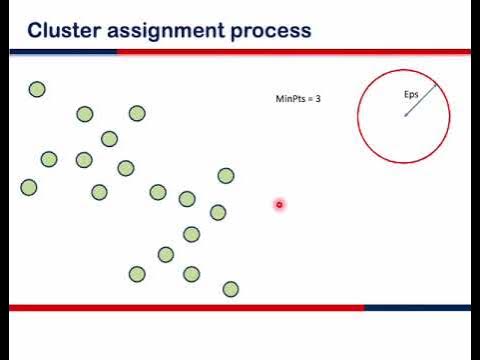#26 Density Based Clustering - DBSCAN Algorithm |DM|
Summary
TLDRIn this video, the speaker explains Density-Based Clustering methods, specifically focusing on DBSCAN (Density-Based Spatial Clustering of Applications with Noise). The video introduces key concepts such as clustering, the DBSCAN algorithm's two essential parameters (epsilon and minimum points), and categorizes data points into core, boundary, and noise points. The explanation includes a practical example to clarify these concepts, making it easy for viewers to understand how DBSCAN works. The video concludes with a brief teaser about the next topic: Grid-Based Clustering.
Takeaways
- 😀 Density-based clustering is one of the four main clustering methods in data mining.
- 😀 In density-based clustering, data objects are grouped based on their density, which refers to how many data points are in a particular area.
- 😀 DBSCAN (Density-Based Spatial Clustering of Applications with Noise) is an algorithm used in density-based clustering.
- 😀 DBSCAN requires two input parameters: epsilon (ε) and minimum points.
- 😀 Epsilon (ε) is the radius of a circle drawn around a data point, while minimum points refer to the minimum number of points that must lie inside this circle for it to be considered a core point.
- 😀 A core point satisfies the minimum points condition, meaning that within the radius (ε), there are enough data points to be considered part of a cluster.
- 😀 A boundary point is a point that is within the neighborhood of a core point but doesn't satisfy the minimum points condition to be a core point.
- 😀 A noise point does not satisfy the conditions for being a core or boundary point and is considered an outlier.
- 😀 Core points are central to forming clusters, with their surrounding boundary points extending the cluster.
- 😀 DBSCAN categorizes data points into three types: core points, boundary points, and noise points, based on their spatial relationships and density.
Q & A
What is density-based clustering?
-Density-based clustering is a method of grouping data objects based on the density of points in a given area. The higher the concentration of data points in a region, the more likely they are to form a cluster.
How does density-based clustering differ from other clustering methods?
-Unlike partitioning methods like k-means, which use centroids to group data, or similarity-based methods, density-based clustering groups data based on how many points are present in a specific region. It is useful for identifying irregularly shaped clusters and noise.
What is DBSCAN?
-DBSCAN (Density-Based Spatial Clustering of Applications with Noise) is a density-based clustering algorithm that groups data based on density and identifies noise points that do not belong to any cluster.
What parameters are used in DBSCAN?
-DBSCAN requires two parameters: epsilon (ε), which defines the radius of a circle around a data point, and minimum points (MinPts), which specifies the minimum number of points required inside the epsilon radius to form a cluster.
What is the significance of epsilon in DBSCAN?
-Epsilon (ε) represents the radius around a data point. It determines how far around a point you will search for other points to form a cluster. A smaller epsilon may lead to many small clusters, while a larger epsilon could result in fewer but larger clusters.
What does the 'minimum points' parameter represent in DBSCAN?
-The 'minimum points' parameter (MinPts) specifies the minimum number of points that must exist within the epsilon radius for a point to be classified as a core point. If there are fewer than MinPts points within the radius, the point is not considered a core point.
What are core points in DBSCAN?
-Core points are data points that have at least the minimum number of points (MinPts) within their epsilon radius. These points are at the center of clusters in DBSCAN.
What are boundary points in DBSCAN?
-Boundary points are data points that are within the epsilon radius of a core point but do not have enough points within their own epsilon radius to be core points. These points are neighbors of core points.
What is a noise point in DBSCAN?
-Noise points in DBSCAN are data points that do not belong to any cluster. They are neither core nor boundary points and are considered outliers or anomalies.
Why is DBSCAN useful for clustering irregular shapes?
-DBSCAN is effective for clustering irregularly shaped data because it groups points based on density rather than predefined shapes like circles or squares. This allows it to find clusters of arbitrary shapes and filter out noise points.
Outlines

This section is available to paid users only. Please upgrade to access this part.
Upgrade NowMindmap

This section is available to paid users only. Please upgrade to access this part.
Upgrade NowKeywords

This section is available to paid users only. Please upgrade to access this part.
Upgrade NowHighlights

This section is available to paid users only. Please upgrade to access this part.
Upgrade NowTranscripts

This section is available to paid users only. Please upgrade to access this part.
Upgrade NowBrowse More Related Video

CS190 2P 3 2

Vid-0903 Metode Clustering di Industri (1)

Lec - 22: Clustering in Data Mining Explained | Top Clustering Methods You MUST Know!

DBSCAN (Density Based Spatial Clustering Of Applications with Noise) ll Machine Learning (Hindi)

Introduction to Clustering

#22 Cluster Analysis - Properties, Categories Of Methods |DM|
5.0 / 5 (0 votes)